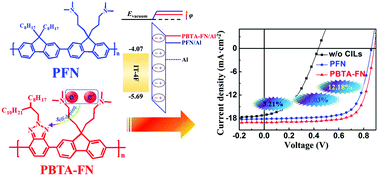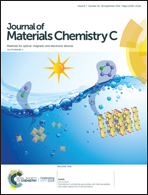Self-doping n-type polymer as a cathode interface layer enables efficient organic solar cells by increasing built-in electric field and boosting interface contact†
Abstract
Self-doped polymer cathode interface materials for organic solar cells have been widely investigated to enhance the ohmic contact between the electrode and the photoactive layer. Herein, a novel polymer named PBTA-FN with self-doping effect was successfully synthesized by incorporating benzotriazole (BTA) as an electron-deficient group and a fluorene containing an amino group. In favor of the n-type backbone and amine-based groups, an obvious n-type doping was obtained, resulting in the dramatically improved conductivity of PBTA-FN. Subsequently, PBTA-FN and PFN as cathode interface layers (CILs) were successfully applied in the organic solar cells based on PBDB-T-2F:IT-4F. A notable power conversion efficiency of 12.18% and 11.03% could be achieved with PBTA-FN and PFN as CILs, respectively. PBTA-FN showed better planarity than PFN as observed from the results obtained via density functional theory. The self-doping behaviour of PBTA-FN was determined by electron paramagnetic resonance, which exhibited a higher mobility and carrier density. The water contact angle results on the surface of the active-layer/PBTA-FN bilayer suggested that the PBTA-FN surface polarity was improved, which was attributed to the larger interface dipole. Thus, PBTA-FN can reduce the work function of an Al electrode and enhance the built-in electric potential, which were further confirmed by ultraviolet photoelectron spectroscopy and Mott Schottky curves, and the related device produced a higher Voc (0.88 V) than PFN (0.86 V). This work provides a deeper understanding of the PBTA-FN interlayer mechanism and has a potential application in optoelectronic devices.

- This article is part of the themed collection: 2019 Journal of Materials Chemistry C Most Popular Articles


 Please wait while we load your content...
Please wait while we load your content...